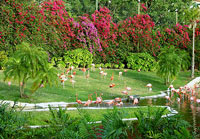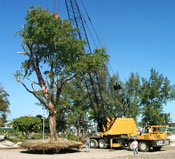Greenscaping From the Ground Up
Parrot Jungle Island’s Holistic Approach to Landscape Site Development
EPA530-F-06-033
September 2006
PJI Fast Facts
- Used 400 tons of compost and more than 5,000 yards of mulch over the life of the project.
- Saved $60,000 during construction using a natural stabilization system.
- Used plants that thrive without the use of fertilizer, pesticides, or fungicides in well-traveled areas.
Summer 2006 marks the second anniversary of Parrot Jungle Island’s (PJI) environmentally sustainable landscaping project. The 18-acre park, located just south of Miami, Florida, completed an extensive four-year building plan, including elevation, vegetation, horticultural, irrigation, and cultivation changes. In the process, this GreenScapes Partner has shown that a holistic approach to landscape site development can be successful, cost-effective, and environmentally sound.
In 2000, the project began with a 4-foot elevation change. Instead of dumping fill dirt over the native soil, PJI removed and preserved several thousand tons of native soil and then used a highly compressible structural fill to raise the topography from 8 to 12 feet above sea level. Finally, PJI applied the native soil from the excavation and contouring processes for landscaping. This approach saved thousands of dollars and provided a landscape medium with excellent drainage and aeration characteristics.
When landscaping, PJI chose native plants accustomed to the island’s climate and soil conditions. In well-traveled areas, it planted vegetation that remains healthy, green, and stable, even under heavy foot-traffic and without using fertilizers, pesticides, or fungicides. To supplement these sustainable plant selection techniques, PJI set up an Integrated Pest Management (IPM) Plan, which uses biological controls to reduce the need for pesticides.

Flamingo Lake in February 2005
PJI also employs a plant health care program that involves the extensive use of park-produced compost, constant mulching, strict irrigation controls, and sustainable cultivation techniques. PJI uses compost from an offsite facility to establish new landscaping and reduce reliance on pesticides and fertilizers. Mulch from tree- and plant-trimmings along with compost promotes healthy soil and prevents erosion on PJI. PJI has used 400 tons of compost from its offsite facility and more than 5,000 yards of mulch from offsite tree trimming operations since the beginning of the project. These natural materials provide a stabilization system that replaces ground cloth and large boulders and saved PJI approximately $60,000 during construction.
To save water on the island, PJI uses sustainable irrigation and filtration techniques. Sprinklers water the gardens only at night and are programmed to spray the largest possible droplet of water, which reduces evaporation and wind throw. PJI recovers excess irrigation water for reuse with a mechanical filtration system. This system filters runoff water, separating it into water and organic matter. The water is reused in the irrigation system while the organic matter is collected in a biofiltration pond, dried out, and used to fertilize the landscape.

As part of its goal to save as many original canopy trees as practical, PJI relocated this 40,000 pound black olive tree after offsite storage.
PJI uses several techniques to manage its landscape, including selective leaf pruning to reduce the number of insects. In addition, instead of cutting down all the trees during construction and then planting new ones, workers removed large canopy trees from the island and held them offsite during the elevation change. Then they repopulated the island with these trees during the landscaping process. Use of these broad, mature trees helps to alleviate the summer “heat island” effect, which occurs when pavement and buildings replace natural land cover and trap heat. Foliage and tree canopy have increased since the construction project ended, supplementing this mitigation process.
For more information, visit Parrot Jungle Island’s Horticulture/Landscaping website ![]() or contact Jeff Shimonski (jeff@tropicaldesigns.com), PJI’s director of horticulture, at 305 206-3148.
or contact Jeff Shimonski (jeff@tropicaldesigns.com), PJI’s director of horticulture, at 305 206-3148.
View and print this fact sheet (PDF) (2 pp, 191K, about PDF)
Disclaimer: Reference herein to any specific commercial products, process, or service by trade name, trademark, manufacturer, or otherwise, does not necessarily constitute or imply its endorsement, recommendation, or favoring by the United States Government. The views and opinions of authors expressed herein do not necessarily state or reflect those of the United States Government, and shall not be used for advertising or product endorsement purposes.
![[logo] US EPA](../gif/logo_epaseal.gif)